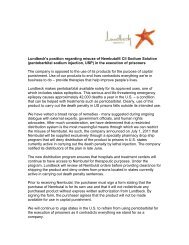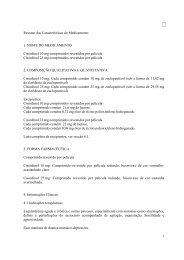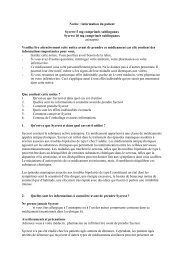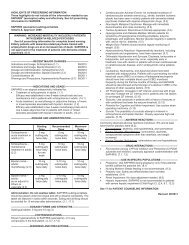Download - Lundbeck
Download - Lundbeck
Download - Lundbeck
You also want an ePaper? Increase the reach of your titles
YUMPU automatically turns print PDFs into web optimized ePapers that Google loves.
<strong>Lundbeck</strong> Magazine 2009<br />
35<br />
Tommy Skovby is a chemical engineer at the <strong>Lundbeck</strong><br />
synthesis factory at Lumsås where he chairs a project that is<br />
to prepare the way for an entirely new way of manufacturing<br />
pharmaceuticals.<br />
As the author of a dissertation on aromatics for<br />
use in the food industry, Tommy Skovby’s<br />
education actually prepared him for a different<br />
line of work. But ever since he began working in<br />
the Quality Department at the Lumsås factory<br />
nine years ago, he has focused on production of<br />
pharmaceuticals. Tommy is deeply involved at<br />
present in a project that, in the foreseeable future,<br />
will change pharmaceutical production as we<br />
know it.<br />
The current method of manufacturing drugs is on<br />
the way to being replaced by a new process which<br />
is fundamentally different, and <strong>Lundbeck</strong> is at the<br />
forefront of developments.<br />
Known as continuous production, the method is<br />
new to the pharmaceutical world, though it has<br />
for many years been used by refineries and<br />
chemical industries. Instead of producing large<br />
amounts of a product in batches and closing<br />
down the production line between each batch,<br />
the new method involves manufacturing only<br />
small amounts on a production line that is in<br />
continuous operation. The process is monitored at<br />
strategic points along the way, enabling errors to<br />
be isolated. An entire production system takes up<br />
only a fraction of the space required for current<br />
systems, and is also cheaper and safer for<br />
employees to operate.<br />
Financial necessity<br />
Small-scale continuous production saves money<br />
in several ways, such as power bills.<br />
“With our current method, we heat up a steel<br />
reactor weighing a couple of tons and then cool it<br />
down again several times during a production<br />
process. In future, we will achieve the same result<br />
with a small steel box at only a fraction of the<br />
cost. The systems are so small that it is possible to<br />
have 10 reactors in a space the size of a family<br />
sitting room. A system of this kind saves money<br />
on both heating and ventilation, and we will be<br />
able to increase production tenfold without<br />
moving a single wall,” Tommy says. Financial<br />
necessity is a significant reason for introducing<br />
continuous production.<br />
“At <strong>Lundbeck</strong> we annually manufacture between<br />
30 and 40 tons of escitalopram, the active<br />
ingredient in Cipralex®. Production takes place in<br />
reactors large enough to contain between 3000<br />
and 4000 litres, and each batch must be put into<br />
sacks or barrels and moved to a warehouse where<br />
they occupy space. If we switch to continuous<br />
production and manufacture 60 grams per<br />
minute, the process can take place in a space<br />
roughly the size of a matchbox,” Tommy explains.<br />
Globalization has added further pressure to keep<br />
production costs down.<br />
“Ten years ago we manufactured most of the raw<br />
materials ourselves, whereas we now purchase<br />
them in the Far East. We must consider how we<br />
can reduce our costs, and it’s a matter of reducing<br />
them as soon as possible,” Tommy continues.<br />
Extremely interesting<br />
As Senior Project Manager, he heads a project<br />
known as Innovative Future Manufacturing IFM.<br />
“When I began working here, I flirted a bit with<br />
process intensification, in which technologies are<br />
combined to improve processes. It was in reality<br />
the forerunner of continuous production, so, in<br />
that sense, I have led the project from the very<br />
beginning – though not full-time. Our main job at<br />
<strong>Lundbeck</strong> is to manufacture, so the project has<br />
been put on hold several times along the way. In<br />
2006, we devised a strategy for tackling<br />
globalization, and the continuous production<br />
project is part of that strategy,” explains Tommy,<br />
who has been an ardent supporter of the new<br />
method all along.<br />
“Someone had to champion the cause, and it<br />
happened to be me. Both because it is extremely<br />
interesting for an engineer from a professional<br />
point of view, and because, in the final analysis,<br />
it is a matter of <strong>Lundbeck</strong>’s production activities<br />
surviving in the long term. That is my driving<br />
force,” Tommy states.<br />
Collaboration with the Technical University<br />
of Denmark<br />
The actual systems for the project are one of the<br />
major challenges. They cannot be bought, but<br />
must be developed from scratch. <strong>Lundbeck</strong> has<br />
therefore entered into a five-year agreement<br />
with DTU concerning development of<br />
applications for the new production method.<br />
Several students are involved in designing<br />
proposals, and the first results have already been<br />
presented for <strong>Lundbeck</strong>.<br />
“The aim of collaborating with DTU is to obtain<br />
a number of building blocks to have at our<br />
disposal. Everyone in the pharmaceutical<br />
industry is interested in the possibilities, but not<br />
many dare experiment with it. It is difficult to<br />
break the habit of batch production, because it<br />
has been the basis for manufacturing in the<br />
pharmaceutical industry for so many years,”<br />
Tommy says. “<strong>Lundbeck</strong> would like to be a<br />
pioneer in the area.”<br />
“But we aren’t in any rush. The project has been<br />
set in motion because <strong>Lundbeck</strong> can see a<br />
number of advantages in the method. And we<br />
aren’t in a great hurry; we would prefer to reap<br />
the results gradually as we move forward,”<br />
concludes Tommy.<br />
PHOTO: Simon ladefoged







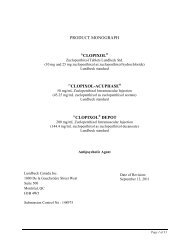
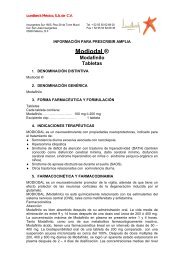

![[Product Monograph Template - Standard] - Lundbeck](https://img.yumpu.com/49015733/1/190x245/product-monograph-template-standard-lundbeck.jpg?quality=85)


